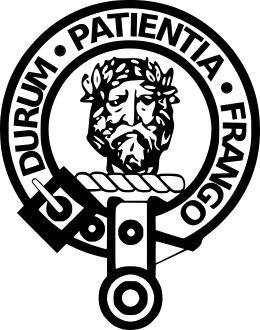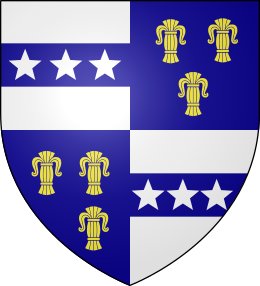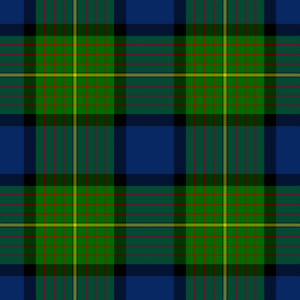Clan Muir facts for kids
Quick facts for kids Clan Muir |
|
|---|---|

Crest: A savage head couped Proper
|
|
| Motto | Durum patientia frango |
| Profile | |
| Region | Lowlands |
| District | East Ayrshire |
| Chief | |
 |
|
| None | |
| Clan Chief | |
| Seat | 32 |
| Historic seat | Rowallan Castle |
Clan Muir is a Scottish clan. It is an armigerous clan, which means it has a coat of arms approved by the Lord Lyon King of Arms in Scotland.
The surname Muir (also spelled Mure or Moore) is often linked to other Scottish clans. For example, some people with the Muir name from Ayrshire might be connected to Clan Boyd. The spelling More or Moore can be a sept (a family linked to a larger clan) of Clan Leslie in Aberdeenshire. There's even genetic proof that some Muirs in Aberdeenshire might have come from the Mure/Muir families in southwest Scotland.
However, not all Muir names are connected to this main group. The name Moir, for instance, is a sept of Clan Gordon in the Highlands, but it's not part of the Mure/Muir/Moore family. A family called Mores/Moores of Drumcork are septs of Clan Grant, but there's no proof they are linked to the main Mure/Muir line. Some people also think Muir might be a sept of Clan Campbell, but even Clan Campbell doesn't think this is likely.
It's important to know that some historians believe there wasn't a formal Clan Muir until the early 1800s or even the early 1900s. If it started in the 1800s, it might have been part of a new interest in Scottish culture. This interest grew after King George IV visited Scotland in 1822 and through the writings of Sir Walter Scott. The idea of Clan Muir likely grew around the history of the Mure/Muir families from Ayrshire and Renfrewshire.
In fact, early books about the Mure/Muir family, like Historie and Descent of the House of Rowallane by Sir William Mure (written before 1657), don't mention a clan system for the family at all. Another old book, Selections from the Family Papers Preserved at Caldwell (1854), also doesn't mention the Mure/Muir families being part of a clan.
Contents
Origins of the Muir Name
The Scottish surname Muir probably came from people who lived near a moor. A moor is an open, often wet, area of land. The name comes from the Scots word more, which means "moor" or "fen" (a type of marshy land).
Some people thought the Muirs of Southwest Scotland came from Ireland. Some even claimed they were linked to Fergus Mór, a king from Ireland. However, genetic tests show that the Mure/Muir/Moore families of southwest Scotland were not genetically linked to Ireland until the 1600s. This was when many Scottish and English people moved to Ulster in Ireland. These tests also show they were not linked to the ancient Gaels.
Instead, the Mure/Muir/Moore families of Southwest Scotland are genetically from the Britonic people. They likely arrived in Southwest Scotland from an area near what is now West Yorkshire, England, in the late 1000s. Before that, there's also genetic evidence that this family line might have been in southwest England. They were among many people who arrived there from mainland Europe during the late Bronze Age.
The first person with the name Mor/de Mor/Mure/Muir who has clear records in Ayr, Scotland, was David de More. He was mentioned as a witness to a special document from King Alexander II between 1214 and 1249.
The Mures of Rowallan
Polkelly seems to have been the first important property owned by the Mures in Scotland. They likely got it in the late 1000s.
The Mures were important people throughout Scottish history. For example, Sir Gilchrist Mure married the daughter of Sir Walter Comyn. This happened with the blessing of King Alexander III because of Sir Gilchrist's help in the Battle of Largs in 1263. This marriage helped the family get their main home at Rowallan Castle. Another story says that Sir Gilchrist Mure was forced out of Rowallan by Sir Walter Cuming. He had to stay at his castle of Polkelly until King Alexander III helped him get Rowallan back. In this version, the family had owned Rowallan for a very long time.

The combined coats of arms of the first Muir of Rowallan could be seen on the oldest part of the castle until the 1700s. Elizabeth Mure, who was the daughter of Sir Adam Mure of Rowallan, married Robert Stewart. He later became King Robert II of Scotland. They had nine children before their marriage was officially approved by the Pope in 1347. Elizabeth died sometime before 1355.
Sir Gilchrist Muir built two chapels. One was called the Well of Saint Laurence, and the other was called Banked of Saint Michael. You could still see parts of these chapels in 1876. He also built a chapel in Kilmarnock, often called Mures Isle.
One of the Sir Robert Mure was killed at the Battle of Sark. Another Sir Robert Mure was known as the Rud of Rowallane. This meant he was very large, strong, and liked to fight. He spent a lot of his family's money. During his life, there was a long fight with the house of Ardoch, which caused a lot of bloodshed. This 'Rud' gave his lands to his grandson John, who married Margaret Boyd, a mistress of King James IV.

Campbells Become Lairds of Rowallan
Sir William Mure was the sixteenth and last Mure to own Rowallan. He fought in Germany with Gustavus Adolphus. One of his granddaughters married Sir James Campbell of Lawers. He was the third son of the Earl of Loudoun. This is how he became the Laird of Rowallan.
His son, Major-General James Mure Campbell of Rowallan (1726–1786), became the fifth Earl of Loudoun in 1782. His only daughter's great-grandson, Charles Rawdon-Hastings, 11th Earl of Loudoun, took over in 1874 and owned the lands of Rowallan as the Laird.
Other Mure Families
Sir Adam Mure had three younger brothers. Their families spread out and settled in many places. These included Caldwell, Aucheneil, Thornton, Glanderstoun, and many others.
Clan Muir Motto
- Motto - Durum Patientia Frango (By patience I break what is hard). This means that with patience, you can overcome difficult things.
Names Connected to Clan Muir
Clan Muir does not have any official septs. However, common variations of the name Muir or Moore are often linked to the clan. Muir, More, Moore, and Mure names are most common in Ayrshire and other areas in the Southwest Lowlands. But some families also moved to Eastern Scotland as early as the 1400s.
Clan Links by Name Spelling
- Muir/Mure/Moore - often linked to Clan Campbell
- Moir/Moire - often linked to Clan Gordon
- Moore - often linked to Clan Leslie
- Moore/More - often linked to Clan Grant
Becoming a Clan Member
Clan membership is usually decided by your surname. If your family name is a sept name that could belong to several clans, you can choose which clan to join. You might pick a clan from the area your family originally came from. Or, if you don't know where they came from, you can choose the clan your family has traditionally been part of.
You can also offer your loyalty to any chief by joining their clan society or by wearing their tartan. If a chief accepts you, you can be considered a member of that clan. Members of Clan Muir who don't choose to join another clan, or who don't have a family history with other clans, often wear the Muir tartan.
See also

